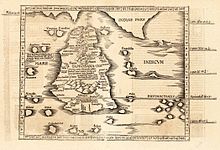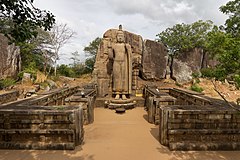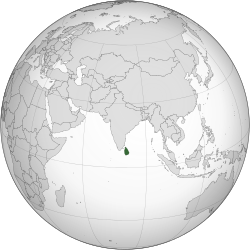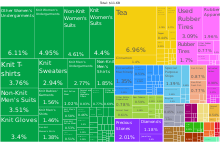Sri Lanka (UK: /sri ˈlæŋkə, ʃriː -/, US: /- ˈlɑːŋkə/ (![]() listen); Sinhala: ශ්රී ලංකා, romanized: Śrī Laṅkā (IPA: [ʃriː laŋkaː]); Tamil: இலங்கை, romanized: Ilaṅkai (IPA: [ilaŋɡaj])), formerly known as Ceylon and officially the Democratic Socialist Republic of Sri Lanka, is an island country in South Asia. It lies in the Indian Ocean, southwest of the Bay of Bengal, separated from the Indian peninsula by the Gulf of Mannar and the Palk Strait. Sri Lanka shares a maritime border with the Maldives in the south-west and India in the north-west.
listen); Sinhala: ශ්රී ලංකා, romanized: Śrī Laṅkā (IPA: [ʃriː laŋkaː]); Tamil: இலங்கை, romanized: Ilaṅkai (IPA: [ilaŋɡaj])), formerly known as Ceylon and officially the Democratic Socialist Republic of Sri Lanka, is an island country in South Asia. It lies in the Indian Ocean, southwest of the Bay of Bengal, separated from the Indian peninsula by the Gulf of Mannar and the Palk Strait. Sri Lanka shares a maritime border with the Maldives in the south-west and India in the north-west.
Sri Lanka has a population of approximately 22 million people and is home to many cultures, languages, and ethnicities. The Sinhalese people form the majority of the nation’s population, followed by the Tamils, who are the largest minority group and are concentrated in northern Sri Lanka; both groups have played an influential role in the island’s history. Other long-established groups include the Moors, Indian Tamils, Burghers, Malays, Chinese, and Vedda.[14]
Sri Lanka’s documented history goes back 3,000 years, with evidence of prehistoric human settlements that dates back 125,000 years.[15] The earliest known Buddhist writings of Sri Lanka, known collectively as the Pāli canon, date to the fourth Buddhist council, which took place in 29 BCE.[16][17] Also called the Teardrop of India, or the Granary of the East, Sri Lanka’s geographic location and deep harbours have made it of great strategic importance, from the earliest days of the ancient Silk Road trade route to today’s so-called maritime Silk Road.[18][19][20] Because its location made it a major trading hub, it was already known to both East Asians and Europeans as long ago as the Anuradhapura period. During a period of great political crisis in the Kingdom of Kotte, the Portuguese arrived in Sri Lanka and sought to control the island’s maritime trade, with a part of Sri Lanka subsequently becoming a Portuguese possession. After the Sinhalese-Portuguese war, the Dutch Empire and the Kingdom of Kandy took control of those areas. The Dutch possessions were then taken by the British, who later extended their control over the whole island, colonising it from 1815 to 1948. A national movement for political independence arose in the early 20th century, and in 1948, Ceylon became a dominion. The dominion was succeeded by the republic of Sri Lanka in 1972. Sri Lanka’s more recent history was marred by a 26-year civil war, which began in 1983 and ended in 2009, when the Sri Lanka Armed Forces defeated the Liberation Tigers of Tamil Eelam.[21]
Sri Lanka is a developing country, ranking 73rd on the Human Development Index. It is the highest-ranked South Asian nation in terms of development and has the second-highest per capita income in South Asia. However, the ongoing economic crisis has resulted in the collapse of its currency, rising inflation, and a humanitarian crisis due to a severe shortage of essentials. It has also led to an eruption of street protests, with citizens successfully demanding that the President and the Government step down.[22] The country has had a long history of engagement with modern international groups: it is a founding member of the SAARC and a member of the United Nations, the Commonwealth of Nations, the G77 and the Non-Aligned Movement.
Toponymy
In antiquity, Sri Lanka was known to travellers by a variety of names. According to the Mahāvaṃsa, the legendary Prince Vijaya named the island Tambapaṇṇĩ (“copper-red hands” or “copper-red earth”), because his followers’ hands were reddened by the red soil of the area where he landed.[23][24] In Hindu mythology, the term Lankā (“Island”) appears but it is unknown whether it refers to the modern day state. But scholars generally agree that it must have been Sri Lanka because it is so stated in the 5th century Sri Lankan text Mahavamsa.[25] The Tamil term Eelam (Tamil: ஈழம், romanized: īḻam) was used to designate the whole island in Sangam literature.[26][27] The island was known under Chola rule as Mummudi Cholamandalam (“realm of the three crowned Cholas”).[28]
Ancient Greek geographers called it Taprobanā (Ancient Greek: Ταπροβανᾶ) or Taprobanē (Ταπροβανῆ)[29] from the word Tambapanni. The Persians and Arabs referred to it as Sarandīb (the origin of the word “serendipity“) from Sanskrit Siṃhaladvīpaḥ.[30][31] Ceilão, the name given to Sri Lanka by the Portuguese Empire when it arrived in 1505,[32] was transliterated into English as Ceylon.[33] As a British crown colony, the island was known as Ceylon; it achieved independence as the Dominion of Ceylon in 1948.
The country is now known in Sinhala as Śrī Laṅkā (Sinhala: ශ්රී ලංකා) and in Tamil as Ilaṅkai (Tamil: இலங்கை, IPA: [iˈlaŋɡaɪ]). In 1972, its formal name was changed to “Fr
The pre-history of Sri Lanka goes back 125,000 years and possibly even as far back as 500,000 years.[37] The era spans the Palaeolithic, Mesolithic, and early Iron Ages. Among the Paleolithic human settlements discovera (37,000 BP), named after the Chinese traveller monk Faxian;[38] Batadombalena (28,500 BP);[39] and Belilena (12,000 BP) are the most important. In these caves, archaeologists have found the remains of anatomically modern humans which they have named Balangoda Man, and other evidence[40] suggesting that they may have engaged in agriculture and kept domestic dogs for driving game.[41]
The earliest inhabitants of Sri Lanka were probably ancestors of the Vedda people,[42] an indigenous people numbering approximately 2,500 living in modern-day Sri Lanka.
During the protohistoric period (1000–500 BCE) Sri Lanka was culturally united with southern India,[43] and shared the same megalithic burials, pottery, iron technology, farming techniques and megalithic graffiti.[44][45] This cultural complex spread from southern India along with Dravidian clans such as the Velir, prior to the migration of Prakrit speakers.[46][47][44]
One of the first written references to the island is found in the Indian epic Ramayana, which provides details of a kingdom named Lanka that was created by the divine sculptor Vishvakarma for Kubera, the God of Wealth.[48] It is said that Kubera was overthrown by his rakshasa stepbrother, Ravana.[49]
Ancient history

According to the Mahāvamsa, a Pāḷi chronicle written in the 5th century CE, the original inhabitants of Sri Lanka are said to be the Yakshas and Nagas. Ancient cemeteries that were used before 600 BCE have also been discovered in Sri Lanka.[50] Sinhalese history traditionally starts in 543 BCE with the arrival of Prince Vijaya, a semi-legendary prince who sailed with 700 followers to Sri Lanka, after being expelled from Vanga Kingdom (present-day Bengal).[51] He established the Kingdom of Tambapanni, near modern-day Mannar. Vijaya (Singha) is the first of the approximately 189 monarchs of Sri Lanka described in chronicles such as the Dipavamsa, Mahāvaṃsa, Cūḷavaṃsa, and Rājāvaliya.[52]
Once Prakrit speakers had attained dominance on the island, the Mahavamsa further recounts the later migration of royal brides and service castes from the Tamil Pandya Kingdom to the Anuradhapura Kingdom in the early historic period.[53]

The Anuradhapura period (377 BCE – 1017 CE) began with the establishment of the Anuradhapura Kingdom in 380 BCE during the reign of Pandukabhaya. Thereafter, Anuradhapura served as the capital city of the country for nearly 1,400 years.[54] Ancient Sri Lankans excelled at building certain types of structures such as tanks, dagobas and palaces.[55] Society underwent a major transformation during the reign of Devanampiya Tissa, with the arrival of Buddhism from India. In 250 BCE,[56] Mahinda, a bhikkhu and the son of the Mauryan Emperor Ashoka arrived in Mihintale carrying the message of Buddhism.[57] His mission won over the monarch, who embraced the faith and propagated it throughout the Sinhalese population.[58]
Succeeding kingdoms of Sri Lanka would maintain many Buddhist schools and monasteries and support the propagation of Buddhism into other countries in Southeast Asia. Sri Lankan Bhikkhus studied in India’s famous ancient Buddhist University of Nalanda, which was destroyed by Bakhtiyar Khilji. It is probable that many of the scriptures from Nalanda are preserved in Sri Lanka’s many monasteries and that the written form of the Tripiṭaka, including Sinhalese Buddhist literature, were part of the University of Nalanda.[59] In 245 BCE, bhikkhuni Sanghamitta arrived with the Jaya Sri Maha Bodhi tree, which is considered to be a sapling from the historical Bodhi Tree under which Gautama Buddha became enlightened.[60] It is considered the oldest human-planted tree (with a continuous historical record) in the world. (Bodhivamsa)
Democratic Socialist Republic of Sri Lanka | |
|---|---|
| Anthem: “Sri Lanka Matha“ (English: “Mother Sri Lanka”) | |
 | |
| Capital |
|
| Largest city | Colombo |
| Official languages | |
| Recognised languages | English |
| Ethnic groups (2012[4]) |
|
| Religion (2012) | 70.2% Buddhism (official)[5] 12.6% Hinduism 9.7% Islam 7.4% Christianity 0.1% Other/None |
| Demonym(s) | Sri Lankan |
| Government | Unitary semi-presidential republic[6] |
| Ranil Wickremesinghe | |
| Dinesh Gunawardena | |
| Mahinda Yapa Abeywardena | |
| Jayantha Jayasuriya | |
| Legislature | Parliament |
| Formation | |
| 543 BCE | |
| 437 BCE | |
| 437 BCE–1017 CE | |
| 1017–1070 | |
| 1070–1236 | |
| 1215–1619 | |
| 1220–1345 | |
| 1341–1412 | |
| 1412–1597 | |
| 1521–1593 | |
| 1469–1815 | |
| 1796 | |
• Kandyan Convention signed | 1815 |
| 1796–1948 | |
| 4 February 1948 | |
• Republic | 22 May 1972 |
| 7 September 1978 | |
| Area | |
• Total | 65,610.2 km2 (25,332.2 sq mi) (120th) |
• Water (%) | 4.4 |
| Population | |
• 2022 estimate | |
• 2012 census | 20,277,600[10] |
• Density | 337.7/km2 (874.6/sq mi) (24th) |
| GDP (PPP) | 2023 estimate |
• Total | |
• Per capita | |
| GDP (nominal) | 2023 estimate |
• Total | |
• Per capita | |
| Gini (2016) | 39.8[12] medium |
| HDI (2021) | high · 73rd |
| Currency | Sri Lankan rupee (Rs) (LKR) |
| Time zone | UTC+5:30 (SLST) |
| Date format |
|
| Driving side | left |
| Calling code | +94 |
| ISO 3166 code | LK |
| Internet TLD | |
Website gov.lk | |
| Flag | Lion Flag |
|---|---|
| Emblem | Gold Lion Passant |
| Anthem | “Sri Lanka Matha“ |
| Butterfly | Sri Lankan birdwing |
| Animal | Grizzled giant squirrel |
| Bird | Sri Lanka junglefowl |
| Flower | Blue water lily |
| Tree | Ceylon ironwood (nā) |
| Sport | Volleyball |
| Source: [208][209] | |






